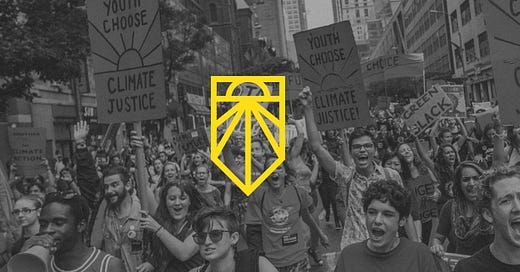What 2024 Means for Young Voters
One of the most important parts of the Democratic Party has the most to lose from not participating in the upcoming election cycle.
And now we move on to another part of the mini-series on what 2024 means for you, the people of America.
This time, we will be focusing on young voters. Once again, on a brief side note, here are some filing deadlines for future candidates—including for collecting signatures to appear on the ballot itself this year:
Some 2024-related posts will highlight points made in previous blog posts, so feel free to check out my past work on my Substack and Medium pages. Also feel welcome to reach out to me on LinkedIn with any comments or questions.
Many pundits refer to suburban voters as the kryptonite of Donald Trump since 2016. This is not much different from the rural voters that Democratic Party leaders need to compete with and draw away from Republicans, especially down ballot.
On a similar note—and I do not mean this as an insult—it seems young voters are the Achilles’ heel of President Joe Biden’s own 2024 reelection campaign. His reelection will be heavily reliant on youth turnout.
President Biden’s weaknesses among young voters are the most notable of all the vulnerabilities he has out there. To be clear, there are many base constituencies President Biden needs to shore up. Although young voters are by no means a monolithic bloc (just like any other demographic group), they are the most fragile of all the party base groups right now.
It is not difficult to understand why. Look at past history. President Biden is known as an old-school Democrat that many older voters relate to both in his policy positions and his demeanor. Not so much young voters. The styles are different, and times have changed. Biden is the political elder statesman, while many young voters are just getting involved into politics (not to say that Biden did not know what challenging the status quo was like. He did it in 1972 in his first Senate campaign to upset a prominent Nixon ally in Delaware).
Joe Biden has historically been a moderate within the Democratic Party itself—never mind in the United States Senate during the heydays—having been close with Presidents Jimmy Carter and Barack Obama, and having dealt with bipartisan old-school Republicans like Richard Lugar, John McCain, and Pete Domenici. The types of things that occurred then are things that are no longer applicable now and that the next generation will not likely see in the near-future. For example, reasonable compromises with this radical right-wing party are near impossible. The GOP won’t even support an immigration bill compromise of their own making on their own terms. Hence the GOP’s new nickname: the “Government Obstruction Party”.
For many young voters that constitute the progressive base, President Biden is “the establishment (the Third Way as it has been called), an old, outdated way of doing things that they have been challenging for years. To be clear, President Biden’s working-class background and his openness to taking on progressive causes makes him far better than, say, a Hillary or Bill Clinton. However, the common affiliation between Biden and those in his political generation have complicated the president’s relationship with a more progressive & younger party base. Not to mention the influence of extremely polarizing actors like Rahm Emanuel and Gina Raimondo (who is additionally a very prominent ally of the online gambling industry).
In ways similar (though nowhere near identical) to Clinton’s own notable drubbing back in 2016, Biden was getting crushed among young voters by both Bernie Sanders and Elizabeth Warren, who represented the ever-growing progressive movement insurgency in the 2020 presidential primaries. Even Pete Buttigieg and Amy Klobuchar had been getting more support from younger voters than Biden in the earliest contests.
Yet, the problems have cratered to a new low. So what is happening? What can be done? And what advice do I have, if any?
Young voters are definitively an influential bloc of voters in the American electorate as a whole. Their maximum strength has been shown in 2008 and 2012. On the other hand, this generation has missed opportunities to fully mobilize in the same way the social conservative grassroots have. Thus, these progressives have failed to permanently remake the Democratic Party, in the same way social conservatives remade the Republican party, in 2016 and 2020.
There is great potential in the power of young voters. But as of now, there is not enough to counter the other group of older, more moderate/conservative voters. By proportion, young voters turn out the least. On a good year, young voters might be somewhere around 17% or 18% of the voters in a given election year. On a bad year, it might be 11% or 12% of the entire electorate—and usually towards the lower end of that on average. As such, the progressive movement has been self-handicapped by not having the kind of reliance on the voters it often needs the most. Likewise, with the general election, increasing the numbers and proportion of young voters as mentioned here would fundamentally reshape the party systems and the electoral map. Generation Z, X, and the Millennials can be real 2024 kingmakers in such a crucial time for our country.
Older voters have influenced elections as the most likely age demographic to turn out. A show of young voter turnout in the margins can reshape all kinds of races down ballot, making the differences between victory and defeat. Like Florida’s 36,000 vote margin between Ron DeSantis and Andrew Gillum for governor in 2018, Georgia’s 11,780 vote margin between Biden and Trump in 2020, Arizona’s 17,000 votes separating Katie Hobbs and Kari Lake in 2022, Nevada’s 8,000 vote margin between Catherine Cortez Masto and Adam Laxalt in 2022, and North Carolina’s 74,000 vote margin that separated Trump and Biden in 2020.
That is part of my point to my fellow cohorts in the youngest generations. I realize that many of you are not big Biden fans. I am a Biden fan, but even I will admit that he was not my top choice back in 2020 either. Many of you wanted a Sanders or Warren presidency. Or maybe you even wanted that unknown mayor from South Bend no one even heard about until late 2019. Many of us wanted a larger progressive footprint in Congress and all across the state legislatures.
In spite of all that, there is a lot we still have accomplished. Without relitigating that any further here, the takeaway is this: Biden could have gotten much more done if not for the circumstances of full GOP obstruction and the obstructionism of two “Democratic” senators (i.e., Joe “Coal” Manchin and Kyrsten Sinema). Biden still achieved a lot nonetheless, and he can get much more done in his 2nd term if you give him that chance.
Because the President knows we need voting rights on the books—in contrast to all the Senate Republicans except Lisa Murkowski—who decided to filibuster legislation to counter the New Jim Crow laws in the South built on 2020 election denial. The President knows we need comprehensive immigration reform that also protects DREAMers and DACA recipients—instead of trying to snake-oil salesman us into Band-Aid promises many on the other side will never commit to even as we speak right now. A real bipartisan immigration reform package can come on our terms in 2025 with your help.
The President knows we need criminal justice reform and a revamping of drug policies—including marijuana legalization—that will equalize society more and reap benefits for all of our communities. The President knows we need campaign finance reform and is waiting on Congress to pass laws to do just that. The President wants gun safety legislation on his desk and the ability to codify the right to an abortion with help from Congress and the States. The President wants to sign the Equality Act into law, and finally ratify the Equal Rights Amendment into the U.S. Constitution at last.
President Biden, all told, wants to enact the rest of his unprecedented Build Back Better Agenda and the campaign promises he made in 2020 on that very message. It might not be the single-payer healthcare system we hoped for, need, and deserve, or a Green New Deal-scale commitment, but it lays the foundations for them. We might not have tuiton-free public colleges across the board, but major debt forgiveness efforts are a step in the right direction. If we can have a session as productive as the 1960s and 1930s with a tied Senate and a similarly narrowly divided House, what could not be done with more involvement and engagement from young voters?
Especially if we can finally nix the filibuster as almost all of us want to do?
And yes, President Biden is the only presidential candidate in this race who could possibly move us towards the two-state solution. That is why Trump is without a doubt Netanyahu’s favorite candidate.
Unlike Biden, Trump will not support any of these things. He will work to undo them. And not just in the old style of keeping promises to repeal the Affordable Care Act once more, or revoking our commitment to the Paris Climate Accords, or giving more tax cuts to rich people who do not need it. He will undo progress entirely will ideas like rounding up all immigrants, expanding his old Muslim ban, eroding voting rights and civil rights permanently, firing all federal employees, pardoning the 1/6 insurrectionists, possibly following Vivek Ramaswamy in increasing the voting age to 25, declaring martial law, and terminating the United States Constitution altogether.
Young voters have the most to gain, and the most to lose, from 2024. It makes it even more important for young people to support the Biden-Harris campaign based on the President’s record, and Trump’s own promises of retribution. The only person who can continue this work, and beat Donald Trump with his tax cuts, ACA repeal plans, junk science, and Muslim bans, is President Joe Biden. Not Cornel West, RFK Jr., Jill Stein, Joe Manchin, or Pat McCrory.






Wonderful work.